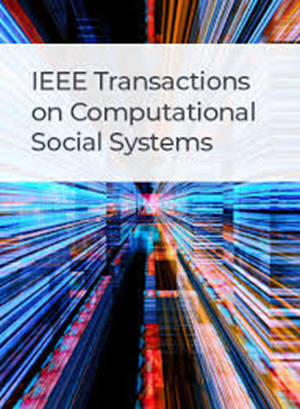Multiknowledge and LLM-Inspired Heterogeneous Graph Neural Network for Fake News Detection
IF 4.5
2区 计算机科学
Q1 COMPUTER SCIENCE, CYBERNETICS
IEEE Transactions on Computational Social Systems
Pub Date : 2024-11-13
DOI:10.1109/TCSS.2024.3488191
引用次数: 0
Abstract
The widespread diffusion of fake news has become a critical problem on dynamic social media worldwide, which requires effective strategies for fake news detection to alleviate its hazardous consequences for society. However, most recent efforts only focus on the features of news content and social context without realizing the benefits of large language models (LLMs) and multiple knowledge graphs (KGs), thus failing to improve detection capabilities further. To tackle this issue, we present a multiknowledge and LLM-inspired heterogeneous graph neural network for fake news detection (MiLk-FD), by combining KGs, LLMs, and graph neural networks (GNNs). Specifically, we first model news content as a heterogeneous graph (HG) containing news, entity, and topic nodes and then fuse the knowledge from three KGs to augment the factual basis of news articles. Meanwhile, we leverage TransE to initialize the knowledge features and employ LLaMa2-7B to obtain the initial feature vectors of news articles. After that, we utilize the devised HG transformer to learn news embeddings with specific feature distribution in high-dimensional spaces by aggregating neighborhood information according to metapaths. Finally, a classifier based on multilayer perceptron (MLP) is trained to predict each news article as fake or true. Through experiments, we demonstrate that our proposed framework surpasses ten baselines according to accuracy, precision, F1-score, recall, and ROC in four public real-world benchmarks (i.e., COVID-19, FakeNewsNet, PAN2020, Liar).多知识和法学硕士启发的异构图神经网络假新闻检测
假新闻的广泛传播已成为全球动态社交媒体上的一个严重问题,需要有效的假新闻检测策略来减轻其对社会造成的危害。然而,最近的大多数努力都只关注新闻内容和社会背景的特征,而没有意识到大语言模型(LLM)和多知识图谱(KG)的优势,因此无法进一步提高检测能力。为了解决这个问题,我们提出了一种多知识和 LLM 启发的异构图神经网络假新闻检测(MiLk-FD),它结合了 KG、LLM 和图神经网络(GNN)。具体来说,我们首先将新闻内容建模为包含新闻、实体和主题节点的异构图(HG),然后融合三个 KG 的知识来增强新闻文章的事实基础。同时,我们利用 TransE 来初始化知识特征,并采用 LLaMa2-7B 来获取新闻文章的初始特征向量。之后,我们利用所设计的 HG 变换器,通过根据元路径聚合邻域信息,在高维空间中学习具有特定特征分布的新闻嵌入。最后,训练一个基于多层感知器(MLP)的分类器来预测每篇新闻文章的真假。通过实验,我们证明了我们提出的框架在四个公开真实世界基准(即 COVID-19、FakeNewsNet、PAN2020 和 Liar)中的准确率、精确度、F1-score、召回率和 ROC 均超过了十个基准。
本文章由计算机程序翻译,如有差异,请以英文原文为准。
求助全文
约1分钟内获得全文
求助全文
来源期刊

IEEE Transactions on Computational Social Systems
Social Sciences-Social Sciences (miscellaneous)
CiteScore
10.00
自引率
20.00%
发文量
316
期刊介绍:
IEEE Transactions on Computational Social Systems focuses on such topics as modeling, simulation, analysis and understanding of social systems from the quantitative and/or computational perspective. "Systems" include man-man, man-machine and machine-machine organizations and adversarial situations as well as social media structures and their dynamics. More specifically, the proposed transactions publishes articles on modeling the dynamics of social systems, methodologies for incorporating and representing socio-cultural and behavioral aspects in computational modeling, analysis of social system behavior and structure, and paradigms for social systems modeling and simulation. The journal also features articles on social network dynamics, social intelligence and cognition, social systems design and architectures, socio-cultural modeling and representation, and computational behavior modeling, and their applications.
 求助内容:
求助内容: 应助结果提醒方式:
应助结果提醒方式:


